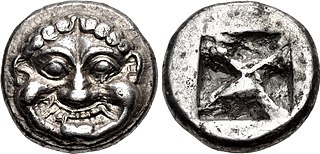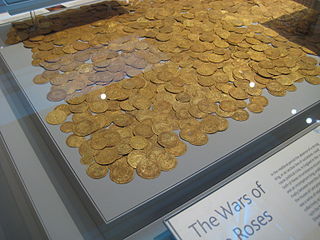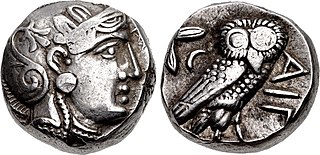Related Research Articles

A coin is a small object, usually round and flat, used primarily as a medium of exchange or legal tender. They are standardized in weight, and produced in large quantities at a mint in order to facilitate trade. They are most often issued by a government. Coins often have images, numerals, or text on them. The faces of coins or medals are sometimes called the obverse and the reverse, referring to the front and back sides, respectively. The obverse of a coin is commonly called heads, because it often depicts the head of a prominent person, and the reverse is known as tails.

The history of ancient Greek coinage can be divided into four periods: the Archaic, the Classical, the Hellenistic and the Roman. The Archaic period extends from the introduction of coinage to the Greek world during the 7th century BC until the Persian Wars in about 480 BC. The Classical period then began, and lasted until the conquests of Alexander the Great in about 330 BC, which began the Hellenistic period, extending until the Roman absorption of the Greek world in the 1st century BC. The Greek cities continued to produce their own coins for several more centuries under Roman rule. The coins produced during this period are called Roman provincial coins or Greek Imperial Coins.

The Coinage of India began anywhere between early 1st millennium BCE to the 6th century BCE, and consisted mainly of copper and silver coins in its initial stage. The coins of this period were Karshapanas or Pana. A variety of earliest Indian coins, however, unlike those circulated in West Asia, were stamped bars of metal, suggesting that the innovation of stamped currency was added to a pre-existing form of token currency which had already been present in the Janapadas and Mahajanapada kingdoms of the Early historic India. The kingdoms that minted their own coins included Gandhara, Kuntala, Kuru, Magadha, Panchala, Shakya, Surasena, Surashtra and Vidarbha etc.

The Achaemenid Empire issued coins from 520 BC–450 BC to 330 BC. The Persian daric was the first gold coin which, along with a similar silver coin, the siglos represented the first bimetallic monetary standard. It seems that before the Persians issued their own coinage, a continuation of Lydian coinage under Persian rule is likely. Achaemenid coinage includes the official imperial issues, as well as coins issued by the Achaemenid provincial governors (satraps), such as those stationed in Asia Minor.
Robert Andrew Glendinning Carson, FBA was a British numismatist.

The British Museum Department of Coins and Medals is a department of the British Museum involving the collection, research and exhibition of numismatics, and comprising the largest library of numismatic artefacts in the United Kingdom, including almost one million coins, medals, tokens and other related objects. The collection spans the history of coinage from its origins in the 7th century BC to the present day, and is representative of both Eastern and Western numismatic traditions.

Punch-marked coins, also known as Aahat coins, are a type of early coinage of India, dating to between about the 6th and 2nd centuries BC. It was of irregular shape. These coins are found over most parts of subcontinent and remained in circulation till the early centuries CE.

The Canterbury-St Martin's hoard is a coin-hoard found in the 19th century at Canterbury, Kent dating from the 6th century. The group, in the World Museum, Liverpool, consists of eight items, including three gold coins mounted with suspension loops for use as pendants. One of these is the Liudhard medalet, the earliest surviving Anglo-Saxon coin. Another coin is in the Bibliotheque Nationale.
Gilbert Kenneth Jenkins was a leading figure in 20th-century numismatics. He was the post-war generation's most important expert in the study of Greek coins and medals and would become Keeper of Coins and Medals at the British Museum in 1965.

Nicholas Gervase Rhodes was a British numismatist who specialised in the coinages of Asia, particularly those of Himalayan kingdoms and pre-Communist Tibet.

Joe Cribb is a numismatist, specialising in Asian coinages, and in particular on coins of the Kushan Empire. His catalogues of Chinese silver currency ingots, and of ritual coins of Southeast Asia were the first detailed works on these subjects in English. With David Jongeward he published a catalogue of Kushan, Kushano-Sasanian and Kidarite Hun coins in the American Numismatic Society New York in 2015. In 2021 he was appointed Adjunct Professor of Numismatics at Hebei Normal University, China.

Barclay Vincent Head was a British numismatist and keeper of the Department of Coins and Medals at the British Museum.
Agnes Baldwin Brett was an American numismatist and archaeologist who worked as the Curator at the American Numismatic Society from 1910 to 1913. She was the first paid curator at the American Numismatic Society. She made important contributions to the study of ancient coinage, medals, and sculpture, whose work was used by later archaeologists. Brett was also a visiting lecturer of archaeology at Columbia University in 1936.
John Allan, was a British numismatist and scholar of Sanskrit. Allan was a noted numismatist and produced the first systematic study of the coins the Gupta Empire, which remains a standard reference today.
A numismatist is a specialist, researcher, and/or well-informed collector of numismatics/coins. Numismatists can include collectors, specialist dealers, and scholar-researchers who use coins in object-based research. Although use of the term numismatics was first recorded in English in 1799, people had been collecting and studying coins long before then all over the world.
Silk Road Numismatics is a special field within Silk Road studies and within numismatics. It is particularly important because it covers a part of the world where history is not always clear – either because the historical record is incomplete or is contested. For example, numismatics has played a central role in determining the chronology of the Kushan kings.

The Kabul hoard, also called the Chaman Hazouri, Chaman Hazouri or Tchamani-i Hazouri hoard, is a coin hoard discovered in the vicinity of Kabul, Afghanistan in 1933. The collection contained numerous Achaemenid coins as well as many Greek coins from the 5th and 4th centuries BCE. Approximately one thousand coins were counted in the hoard. The deposit of the hoard is dated to approximately 380 BCE, as this is the probable date of the least ancient datable coin found in the hoard.

Elizabeth Jean Elphinstone Pirie was a British numismatist specialising in ninth-century Northumbrian coinage, and museum curator, latterly as Keeper of Archaeology at Leeds City Museum from 1960 to 1991. She wrote eight books and dozens of articles throughout her career. She was a fellow of the Royal Numismatic Society, president of the Yorkshire Numismatic Society and a fellow of the Society of Antiquaries of London.

Haim Gitler is an Israeli curator and researcher, specializing in the field of numismatics. He is chief curator of archaeology and curator of numismatics at the Israel Museum, Jerusalem, as well as the President of the Israel Numismatic Society.
References
- ↑ Obituary in the Newsletter of the Oriental Numismatic Society 104 (1987); Obituary in Numismatic Chronicle 1987, vol. 147, p.ii.
- ↑ "Nicholas Lowick" . Retrieved 9 January 2018.
- ↑ Review by Helen W. Brown, in Journal of Islamic Studies, Vol. 6, Issue 2, 1 July 1995, p. 260. https://doi.org/10.1093/jis/6.2.260 https://academic.oup.com/jis/article-abstract/6/2/260/710267?redirectedFrom=PDF
- ↑ Review by Elizabeth Savage, in Journal of Semitic Studies, Volume XXXVII, Issue 1, 1 March 1992, pp. 132–136. https://doi.org/10.1093/jss/XXXVII.1.132 https://academic.oup.com/jss/article-abstract/XXXVII/1/132/1610219?redirectedFrom=PDF